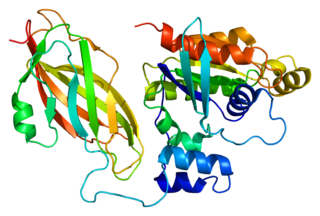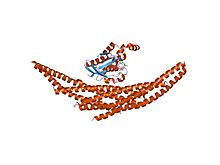
Cell division control protein 42 homolog is a protein that in humans is encoded by the CDC42 gene. Cdc42 is involved in regulation of the cell cycle. It was originally identified in S. cerevisiae (yeast) as a mediator of cell division, and is now known to influence a variety of signaling events and cellular processes in a variety of organisms from yeast to mammals.

FYVE, RhoGEF and PH domain-containing protein 1 (FGD1) also known as faciogenital dysplasia 1 protein (FGDY), zinc finger FYVE domain-containing protein 3 (ZFYVE3), or Rho/Rac guanine nucleotide exchange factor FGD1 is a protein that in humans is encoded by the FGD1 gene that lies on the X chromosome. Orthologs of the FGD1 gene are found in dog, cow, mouse, rat, and zebrafish, and also budding yeast and C. elegans. It is a member of the FYVE, RhoGEF and PH domain containing family.

Rac1, also known as Ras-related C3 botulinum toxin substrate 1, is a protein found in human cells. It is encoded by the RAC1 gene. This gene can produce a variety of alternatively spliced versions of the Rac1 protein, which appear to carry out different functions.

Ras-related protein Rab-6A is a protein that in humans is encoded by the RAB6A gene located in the eleventh chromosome. Its main function is the regulation of protein transport from the Golgi complex to the endoplasmic reticulum and the exocytosis along with the microtubules.

Golgin subfamily A member 2, also known as 130 kDa cis-Golgi matrix protein 1 (GM130) is a protein that in humans is encoded by the GOLGA2 gene.

Rac2 is a small signaling G protein, and is a member of the Rac subfamily of the family Rho family of GTPases. It is encoded by the gene RAC2.

Rho guanine nucleotide exchange factor 7 is a protein that in humans is encoded by the ARHGEF7 gene.

Rho guanine nucleotide exchange factor 6 is a protein that, in humans, is encoded by the ARHGEF6 gene.

General vesicular transport factor p115 is a protein that in humans is encoded by the USO1 gene.

Islet cell autoantigen 1 is a protein that in humans is encoded by the ICA1 gene.

Golgi-associated PDZ and coiled-coil motif-containing protein is a protein that in humans is encoded by the GOPC gene.

Ras-related protein Rab-1A is a protein that in humans is encoded by the RAB1A gene.

Syntaxin-6 is a protein that in humans is encoded by the STX6 gene.

RhoG is a small monomeric GTP-binding protein, and is an important component of many intracellular signalling pathways. It is a member of the Rac subfamily of the Rho family of small G proteins and is encoded by the gene RHOG.

Citron Rho-interacting kinase is an enzyme that in humans is encoded by the CIT gene.

Bicaudal D cargo adaptor 1 is a protein that in humans is encoded by the BICD1 gene.

Arf-GAP with SH3 domain, ANK repeat and PH domain-containing protein 2 is a protein that in humans is encoded by the ASAP2 gene.

GTP-binding protein ARD-1 is a protein that in humans is encoded by the TRIM23 gene.

Arfaptin-2 is a protein that in humans is encoded by the ARFIP2 gene.

Giantin or Golgin subfamily B member 1 is a protein that in humans is encoded by the GOLGB1 gene. Giantin is located at the cis-medial rims of the Golgi apparatus and is part of the Golgi matrix that is responsible for membrane trafficking in secretory pathway of proteins. This function is key for proper localisation of proteins at the plasma membrane and outside the cell which is important for cell function that is dependent on for example receptors and the extracellular matrix function. Recent animal model knockout studies of GOLGB1 in mice, rat, and zebrafish have shown that phenotypes are different between species ranging from mild to severe craniofacial defects in the rodent models to just minor size defects in zebrafish. However, in adult zebrafish a tumoral calcinosis-like phenotype was observed, and in humans such phenotype has been linked to defective glycosyltransferase function.



















